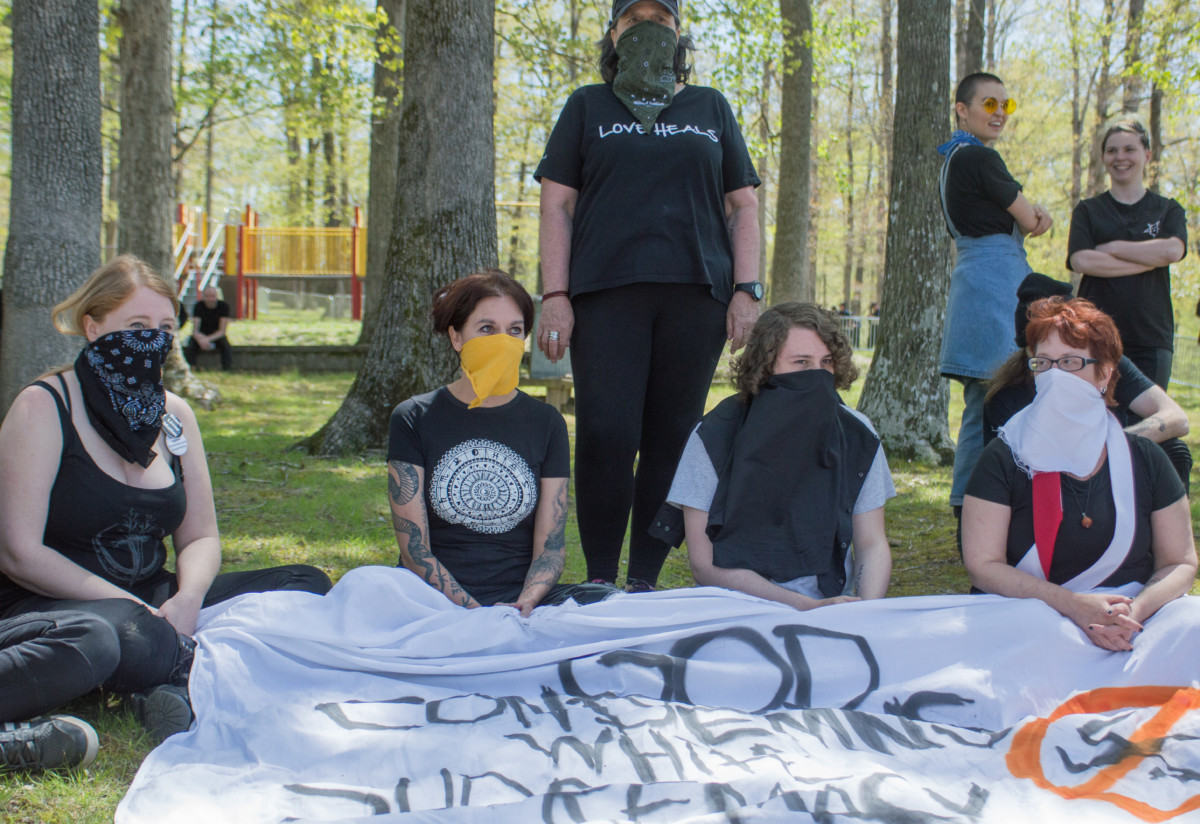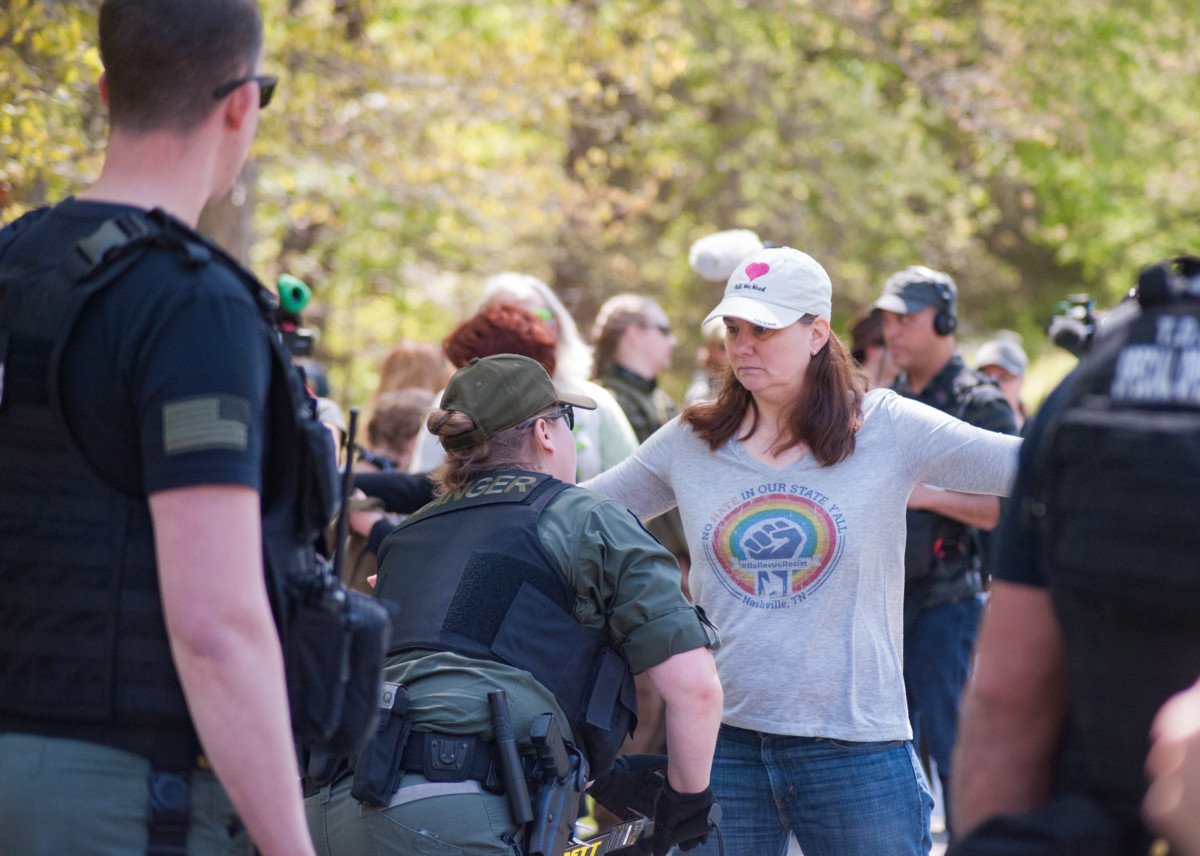“If there was a rattlesnake in my friend’s backyard, I’d sure go tell them,” Tennessee resident and Navy veteran Paul Adams told Truthout. He said that’s why he showed up to protest an annual conference hosted by the white supremacist magazine American Renaissance this April in Burns, Tennessee.
Adams was among about 60 demonstrators confined to a “free speech zone” in front of the Montgomery Bell State Park Inn, which was hosting a three-day conference for white nationalists. Though Adams said he protested Nazis in the 1970s, this year was his first time protesting the American Renaissance convention, which has been held in Burns since 2012. Adams said he’s concerned about the rising power of white nationalists in the US government. “If you would have told me back then that they’d have access to the White House, I don’t know. I would find that hard to believe,” Adams said.
Neo-fascism researcher Mike Isaacson explained to Truthout that conferences like these featuring “suit-and-tie” white nationalist personalities initially “provided a place for white nationalists who had previously only been organizing online to be able to actually meet in real life without having to worry about being monitored.” Further, such conferences “offered a platform to the intelligentsia of the white nationalist right who perhaps did not have the credentials of Jared Taylor.” With degrees from Yale University and the Paris Institute of Political Studies, Taylor is the founder of New Century Foundation and American Renaissance.
Much has been written about the state of the self-described “alt-right” white nationalist movement since it has come under attack from anti-fascist and anti-racist activists. On top of this, far-right individuals and neo-fascist cells have suffered significant blows to their ability to organize, recruit and put boots on the ground due to their own in-fighting, lawsuits filed against them and pressure from anti-fascist groups.

The dissolution of the Traditionalist Worker Party that occurred after its leader, Matthew Heimbach, was arrested for domestic violence charges in March has created a perception that the influence of the movement as a whole is waning. Because Heimbach had been a central figure among young white nationalists for years, his legal troubles, in particular, have led to a lot of declarations that the so-called “alt-right” is spiraling down the drain.
Yet recent writings on the state of the “alt-right” have not included much conversation about white nationalist institutions: publications, nonprofit organizations and “think tanks.” According to Isaacson, the broad nature of the “alt-right” has enabled far-right operators to spread their reactionary ideas — particularly their support for eugenics. This has occurred due to the influence of white nationalist institutions, which exist precisely to facilitate the spread of bigoted ideas.
How White Nationalist Institutions Spread Hate
White nationalist institutions have played a pivotal role over the decades for a movement that has always had to re-strategize its activism and optics after major scandals. In the 1970s and ’80s, members of various white nationalist groups were apprehended and brought up on charges in connection with committing violent crimes. Isaacson points to the murder of the Jewish radio host Alan Berg by the white separatist group The Order in 1984. “Because of the actions of coordinated forms of militancy, a lot of white nationalist leadership ended up getting trapped by the FBI even if they weren’t directly involved in these [crimes],” he told Truthout.
“As a result,” Isaacson says, “white nationalism through the ’90s moved away from formally organized forms of militancy, where instead there were one-man-show media outlets, such as White Aryan Resistance … and advocacy toward leaderless resistance or what they coined the ‘lone-wolf’ strategy.” Essentially, leaders within the white nationalist movement began advocating for “lone-wolf” activism to make it more difficult for people within the movement to get caught up in conspiracy charges. It was also during this period that Taylor founded the New Century Foundation, which publishes American Renaissance, and began holding biennial conferences.
In essence, magazines such as American Renaissance and “think tanks” such as Richard Spencer’s National Policy Institute serve to help legitimize white supremacist and nationalist ideologies and make it easier for white nationalists to share their messages with a broader audience. By dressing up right-wing extremism and bigotry in the trappings of traditional academic disciplines, dangerous ideas such as eugenics can gain footholds closer to the mainstream.
While white nationalism has generally remained on the fringes of the right wing, many prominent members of the movement gained national notoriety in the lead-up to the 2016 presidential election. Far-right ideas though, go back much further than the Trump era. While the far right has created its own platforms (from Breitbart to the Daily Stormer to American Renaissance), it has also been given a voice in the mainstream.
“Bear in mind that when you talk about American Renaissance and you talk about even the [white supremacist] Council of Conservative Citizens … these were mainstream organizations at one point,” says Daryle Lamont Jenkins, executive director of One People’s Project, an organization that researches and monitors the far right. “You used to see them on C-SPAN all the time, the [American Renaissance] conference was broadcast on C-SPAN,” he recalled.
Jenkins pointed out the connections between some of the more extreme but less well-known names on the far right and more familiar far-right personalities. According to Jenkins, Peter Brimelow, editor of the far-right, anti-immigrant website VDARE, served as a mentor to Ann Coulter. Meanwhile Michelle Malkin, another conservative media star, was a contributor at the site. VDARE, which was founded in 1999, contributed $34,591 to help Spencer start up the alternative-right.com in 2010, according to tax documents. VDARE itself received $35,000 from the Pioneer Fund that same year.
“For years, I have been trying to tell people, look out for the Jared Taylors, look out for the Richard Spencers,” Jenkins says. “They weren’t going out there with the sieg heil-ing and the burning crosses; they were in your boardrooms and your schools and your congressional offices. That was their world. And we kept on saying, ‘Look these are the folks who want you to ignore them because they have a vested interest in being a part of today’s society.'”
Most people, unfortunately, did not heed these warnings until the “Unite the Right” rally in Charlottesville last summer, Jenkins says. At the convergence of white nationalists and supremacists ranging from neo-fascist cells to David Duke and Richard Spencer, counter-protester Heather Heyer was killed by James Fields, who marched with the fascist group Vanguard America at the rally before driving his car into a crowd of anti-fascist protesters.
How “Alt-Right” Institutions Get Embedded at Universities
Furthermore, demonstrations by groups such as these had been taking place across the country, many on college campuses, after Spencer and Milo Yiannopoulos used lawsuits to force universities to host their events. Spencer is, of course, part of the far-right institution machine as president of the National Policy Institute, a white nationalist self-styled think tank. Spencer announced a hiatus from his months-long campus speaking tour in mid-March, citing “antifa” as his reason for stepping back. Since the announcement, reports have also revealed that he’s going broke.
Yet far-right extremists are not always just visitors to universities. As tax records from various white nationalist nonprofits show, some of these organizations have given large sums of money to various colleges and universities in the US and abroad, including Arizona State University, Drexel University, and the University of Western Ontario. The University of Western Ontario received $301,326 between 2002 and 2006, all of which went to the Canadian race scientist and former Pioneer Fund president J. Philippe Rushton, according to the Southern Poverty Law Center (Rushton died in 2012). In other words, extremist nonprofits give money to ensure that their bigoted ideas are being “researched,” published and taught to students.
The nonprofit foundation called the Pioneer Fund, which was founded in 1937 by a eugenicist named Wickliffe Preston Draper, has given large amounts of money to university professors, and even had some professors head up the organization. Pioneer Fund gave startup funds to the National Policy Institute and the New Century Foundation. Pioneer Fund gave more than $2.1 million to nearly two-dozen universities or institutions connected to them between 2001 and 2015, in the US and abroad.
Obtaining outside grants for their scholars “is something that universities love,” says Isaacson, “because it means they don’t have to pay them that much, and also gives them the kind of prestige for having received grants for their research.” By pushing academic arguments for white nationalism, he adds, these organizations are able to steer the larger conversation away from politics into pseudo-science.
The Pioneer Fund’s giving is not the only way by which white nationalists insinuate themselves on college campuses via charitable donations. Another major player in funneling white nationalist ideas to universities is William Regnery, who founded the National Policy Institute and the Charles Martel Society, which publishes the Occidental Quarterly, and claims its purpose is to “defend the cultural, ethnic, and racial interests of Western European peoples.” Regnery inherited a multimillion-dollar fortune and has a long history of backing both open white nationalist organizations, as well as more establishment conservative ones. Regnery’s family has had ties to mainstream conservatism for decades and began its influence in US politics in 1940 when his grandfather founded the America First Committee, a group dedicated to stopping the United States from entering World War II. The organization attracted Nazis but disbanded after Pearl Harbor. Regnery was affiliated with the Intercollegiate Studies Institute, a mainstream nonprofit conservative organization that recruits Republicans on college campuses. While he was ostracized from the GOP due to his views on race, his family helped endow the institute.
“Alt-Right” Institutions Help White Supremacists Hold On
Jenkins says that because of shifting demographics in the US, far-right extremists need think tanks and publications like American Renaissance to try to maintain even a limited acceptance of white supremacist ideology within the broader public. “The truth is, they’re basically trying to keep what it is that they had all along that we’ve just simply taken away from them,” he says. White nationalists “feel the need to reclaim that which has been lost to the rest of society;” and their institutions “make advancement more accessible” to them, he says.
As for what’s happening with the “alt-right” now, Isaacson says: “Anti-fascists have definitely made it difficult and have increased the pressure, but I would say that ultimately, these groups have been falling apart because they’ve been in-fighting and fracturing amongst themselves. But I don’t think that they would have done so if not for public opposition to them.”

Jenkins adds that he believes anti-fascist activists are stronger than the white nationalists and that, as a result, the only way the white nationalists “have any kind of strength is when we simply do nothing about them when they come around.”
Researcher Isaacson says white nationalist institutions can be effectively de-platformed by targeting the people and venues that opt to host them. Protesters can’t expect to appeal to would-be hosts’ sense of morality, he says, because “they’ve already chosen to host these people in the first place.” Instead, anti-fascist activists “have to think about things in terms of cost-benefit analysis” for potential hosts. For example, American Renaissance was forced to cancel its 2010 and 2011 conferences after anti-racist activists protested against the hotels American Renaissance had booked.
Isaacson also points to anti-fascist protesters who used militant direct action tactics when Yiannopoulos, who was at that time still a writer for far-right website Breitbart, spoke at the University of California, Berkeley, in 2017. Some protesters set small fires and broke windows of the building where Yiannopoulos was speaking, leading the school to cancel the remainder of his events scheduled for that week. “But it doesn’t have to look that militant,” he says. “There are a number of ways that this can be done.”
While some components of the “alt-right” may be in disarray, activists say that it’s important to keep the pressure on and oppose white nationalist forces, whether they’re marching in the streets or having conferences behind metal barricades and rows of police. Jenkins says ultimately, he’s confident that the far right’s institutions can be stopped. White nationalists are trying to broaden their appeal through their scholarly ties, he says, but “we’re not going to let them.”
Our most important fundraising appeal of the year
December is the most critical time of year for Truthout, because our nonprofit news is funded almost entirely by individual donations from readers like you. So before you navigate away, we ask that you take just a second to support Truthout with a tax-deductible donation.
This year is a little different. We are up against a far-reaching, wide-scale attack on press freedom coming from the Trump administration. 2025 was a year of frightening censorship, news industry corporate consolidation, and worsening financial conditions for progressive nonprofits across the board.
We can only resist Trump’s agenda by cultivating a strong base of support. The right-wing mediasphere is funded comfortably by billionaire owners and venture capitalist philanthropists. At Truthout, we have you.
We’ve set an ambitious target for our year-end campaign — a goal of $250,000 to keep up our fight against authoritarianism in 2026. Please take a meaningful action in this fight: make a one-time or monthly donation to Truthout before December 31. If you have the means, please dig deep.
